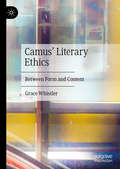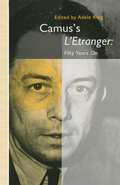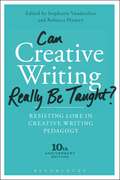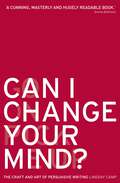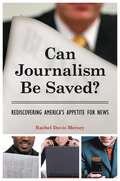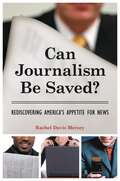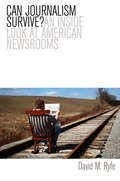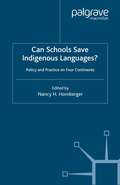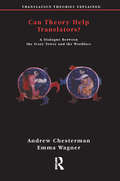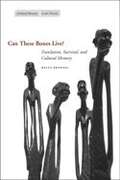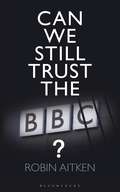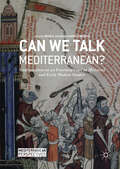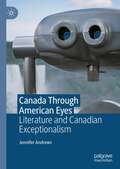- Table View
- List View
Camus at Combat: Writing 1944-1947
by Albert CamusParis is firing all its ammunition into the August night. Against a vast backdrop of water and stone, on both sides of a river awash with history, freedom's barricades are once again being erected. Once again justice must be redeemed with men's blood.Albert Camus (1913–1960) wrote these words in August 1944, as Paris was being liberated from German occupation. Although best known for his novels including The Stranger and The Plague, it was his vivid descriptions of the horrors of the occupation and his passionate defense of freedom that in fact launched his public fame.Now, for the first time in English, Camus at 'Combat' presents all of Camus' World War II resistance and early postwar writings published in Combat, the resistance newspaper where he served as editor-in-chief and editorial writer between 1944 and 1947. These 165 articles and editorials show how Camus' thinking evolved from support of a revolutionary transformation of postwar society to a wariness of the radical left alongside his longstanding strident opposition to the reactionary right. These are poignant depictions of issues ranging from the liberation, deportation, justice for collaborators, the return of POWs, and food and housing shortages, to the postwar role of international institutions, colonial injustices, and the situation of a free press in democracies. The ideas that shaped the vision of this Nobel-prize winning novelist and essayist are on abundant display.More than half a century after the publication of these writings, they have lost none of their force. They still speak to us about freedom, justice, truth, and democracy.
Camus at Combat: Writing 1944-1947
by Albert CamusParis is firing all its ammunition into the August night. Against a vast backdrop of water and stone, on both sides of a river awash with history, freedom's barricades are once again being erected. Once again justice must be redeemed with men's blood.Albert Camus (1913–1960) wrote these words in August 1944, as Paris was being liberated from German occupation. Although best known for his novels including The Stranger and The Plague, it was his vivid descriptions of the horrors of the occupation and his passionate defense of freedom that in fact launched his public fame.Now, for the first time in English, Camus at 'Combat' presents all of Camus' World War II resistance and early postwar writings published in Combat, the resistance newspaper where he served as editor-in-chief and editorial writer between 1944 and 1947. These 165 articles and editorials show how Camus' thinking evolved from support of a revolutionary transformation of postwar society to a wariness of the radical left alongside his longstanding strident opposition to the reactionary right. These are poignant depictions of issues ranging from the liberation, deportation, justice for collaborators, the return of POWs, and food and housing shortages, to the postwar role of international institutions, colonial injustices, and the situation of a free press in democracies. The ideas that shaped the vision of this Nobel-prize winning novelist and essayist are on abundant display.More than half a century after the publication of these writings, they have lost none of their force. They still speak to us about freedom, justice, truth, and democracy.
Camus' Literary Ethics: Between Form and Content
by Grace WhistlerThis book seeks to establish the relevance of Albert Camus’ philosophy and literature to contemporary ethics. By examining Camus’ innovative methods of approaching moral problems, Whistler demonstrates that Camus’ work has much to offer the world of ethics— Camus does philosophy differently, and the insights his methodologies offer could prove invaluable in both ethical theory and practice. Camus sees lived experience and emotion as ineliminable in ethics, and thus he chooses literary methods of communicating moral problems in an attempt to draw positively on these aspects of human morality. Using case studies of Camus’ specific literary methods, including dialogue, myth, mime and syntax, Whistler pinpoints the efficacy of each of Camus’ attempts to flesh-out moral problems, and thus shows just how much contemporary ethics could benefit from such a diversification in method.
Camus’s L’Etranger: Fifty Years on
by Adele KingThese essays on L'Etranger celebrate its continuing influence throughout the world. Contributors come from Algeria, Samoa, India, Russia, France, Britain and the United States. Included are essays by prominent French and English-language authors for whom the novel has been an influential expression of contemporary sensibility. Other essays include feminist interpretations of Meursault, studies of Camus's narrative form, and explorations of the Algerian setting of the novel. Comparative studies show Camus's relation to the New Novel, to Greene and Orwell, to Jules Roy, and to Sartre.
Can Construction Grammar Be Proven Wrong? (Elements in Construction Grammar)
by null Bert CappelleConstruction Grammar has gained prominence in linguistics, owing its popularity to its inclusive approach that considers language units of varying sizes and generality as potential constructions – mentally stored form-function units. This Element serves as a cautionary note against complacency and dogmatism. It emphasizes the enduring importance of falsifiability as a criterion for scientific hypotheses and theories. Can every postulated construction, in principle, be empirically demonstrated not to exist? As a case study, the author examines the schematic English transitive verb-particle construction, which defies experimental verification. He argues that we can still reject its non-existence using sound linguistic reasoning. But beyond individual constructions, what could be a crucial test for Construction Grammar itself, one that would falsify it as a theory? In making a proposal for such a test, designed to prove that speakers also exhibit pure-form knowledge, this Element contributes to ongoing discussions about Construction Grammar's theoretical foundations.
Can Creative Writing Really Be Taught?: Resisting Lore in Creative Writing Pedagogy (10th anniversary edition)
by Stephanie Vanderslice Rebecca ManeryRevised and updated throughout, this 10th-anniversary edition of Can Creative Writing Really Be Taught? is a significantly expanded guide to key issues and practices in creative writing teaching today.Challenging the myths of creative writing teaching, experienced and up-and-coming teachers explore what works in the classroom and workshop and what does not. Now brought up-to-date with new issues that have emerged with the explosion of creative writing courses in higher education, the new edition includes:· Guides to and case studies of workshop practice· Discussions on grading and the myth of "the easy A†?· Explorations of the relationship between reading and writing· A new chapter on creative writing research· A new chapter on games, fan-fiction and genre writing· New chapters on identity and activism
Can Creative Writing Really Be Taught?: Resisting Lore in Creative Writing Pedagogy (10th anniversary edition)
by Stephanie Vanderslice Rebecca ManeryRevised and updated throughout, this 10th-anniversary edition of Can Creative Writing Really Be Taught? is a significantly expanded guide to key issues and practices in creative writing teaching today.Challenging the myths of creative writing teaching, experienced and up-and-coming teachers explore what works in the classroom and workshop and what does not. Now brought up-to-date with new issues that have emerged with the explosion of creative writing courses in higher education, the new edition includes:· Guides to and case studies of workshop practice· Discussions on grading and the myth of “the easy A”· Explorations of the relationship between reading and writing· A new chapter on creative writing research· A new chapter on games, fan-fiction and genre writing· New chapters on identity and activism
Can I Change Your Mind?: The Craft and Art of Persuasive Writing
by Lindsay CampThese days, we all need the ability to argue a case effectively inwriting. Drawing on his long experience as a leading copywriter,Lindsay Camp shows how it's done-whether the 'end product' is a glossy magazine ad, a new business proposal, a page for the company website, or just a hasty email to your boss. Engaging, entertaining and-as you'd expect-highly persuasive, Can I Change Your Mind? will change the way you think about the words you use for ever.'This is a cunning, masterly and hugely readable book. You'll learnat least as much from how he writes as from what he writes about-andthat's saying a great deal.' Jeremy Bullmore (columnist for Campaign, Management Today and The Guardian)'I hope it's read by every marketing manager, sales director, customer relations officer and chief executive in the land.' Jeremy Bullmore'A masterpiece in persuasive writing.' Management Today, (September 2007)
Can I Have a Word?: A Fun Guide to Winning Word Games
by Nick FawcettCan I Have a Word? is the ultimate strategy book for word-game lovers. It introduces the reader to a host of weird and wacky words that will not only help them to become better word-game players but also enhance their enjoyment of competing. It covers key word-game themes, the mastery of which is vital for success, such as: - Two- and three-letter words- Using a Q, Z, J or X to maximum effect- Dealing with the letter V and other problem tiles- Coping with a rack full of consonants or one heavy in vowels- Making seven- and eight-letter words - Tips for victory.Readers will find this amusing, light-hearted book immeasurably enriches their vocabulary, enabling them, without the drudgery of studying a dictionary, to recall all kinds of unusual and interesting words just when they need them most.
Can Jane Eyre Be Happy?: More Puzzles in Classic Fiction (Oxford World's Classics Ser.)
by John Sutherland'Wonderful...concise, witty, effortlessly learned.' Sunday Times How does Magwitch swim to shore with a great iron on his leg? Where does Fanny Hill keep her contraceptives? Whose side is Hawkeye on? And how does Clarissa Dalloway get home so quickly? In this new edition sequel to the enormously successful Is Heathcliff a Murderer?, John Sutherland plays literary detective and investigates 32 literary conundrums, ranging from Daniel Defoe to Virginia Woolf. As in its universally loved predecessor, the questions and answers are ingenious and convincing, and return the reader with new respect to the great novels that inspire them.
Can Journalism Be Saved?: Rediscovering America's Appetite for News
by Rachel Davis MerseyThis book challenges the once-dominant social responsibility model and argues that a new, "individual-first" paradigm is what will allow journalism to survive in today's crowded media marketplace.By some measures, it would seem that print journalism is dying. Journalism recently suffered one of its worst circulation declines in years: a drop of more than ten percent in the a six month period ending September 30, 2009. The Rocky Mountain News in Denver, CO, closed its doors in 2009—after it dominated the AP awards in 2008, and was lauded for an investigative expose on unfair treatment of former nuclear workers. Even the New York Times and the Washington Post are experiencing financial trouble. But print advertising revenue still trumps online advertising revenue ten-fold. Is there hope yet for traditional journalism?This book reviews the complicated challenge facing journalism, tracing its 19th-century community-oriented origins and documenting the vast expansion of the news business via blogs and other Internet-enabled outlets, user-generated content, and news-like alternatives. The author argues that a radical shift in mindset—striving to meet each individual's demands for what he wants to know—will be necessary to save journalism.
Can Journalism Be Saved?: Rediscovering America's Appetite for News
by Rachel Davis MerseyThis book challenges the once-dominant social responsibility model and argues that a new, "individual-first" paradigm is what will allow journalism to survive in today's crowded media marketplace.By some measures, it would seem that print journalism is dying. Journalism recently suffered one of its worst circulation declines in years: a drop of more than ten percent in the a six month period ending September 30, 2009. The Rocky Mountain News in Denver, CO, closed its doors in 2009—after it dominated the AP awards in 2008, and was lauded for an investigative expose on unfair treatment of former nuclear workers. Even the New York Times and the Washington Post are experiencing financial trouble. But print advertising revenue still trumps online advertising revenue ten-fold. Is there hope yet for traditional journalism?This book reviews the complicated challenge facing journalism, tracing its 19th-century community-oriented origins and documenting the vast expansion of the news business via blogs and other Internet-enabled outlets, user-generated content, and news-like alternatives. The author argues that a radical shift in mindset—striving to meet each individual's demands for what he wants to know—will be necessary to save journalism.
Can Journalism Survive?: An Inside Look at American Newsrooms
by David M. RyfeJournalists have failed to respond adequately to the challenge of the Internet, with far-reaching consequences for the future of journalism and democracy. This is the compelling argument set forth in this timely new text, drawing on the most extensive ethnographic fieldwork in American newsrooms since the 1970s. David Ryfe argues that journalists are unable or unwilling to innovate for a variety of reasons: in part because habits are sticky and difficult to dislodge; in part because of their strategic calculation that the cost of change far exceeds its benefit; and in part because basic definitions of what journalism is, and what it is for, anchor journalism to tradition even when journalists prefer to change. The result is that journalism is unraveling as an integrated social field; it may never again be a separate and separable activity from the broader practice of producing news. One thing is certain: whatever happens next, it will have dramatic consequences for the role journalism plays in democratic society and perhaps will transform its basic meaning and purpose. Can Journalism Survive? is essential and provocative reading for all concerned with the future of journalism and society.
Can Journalism Survive?: An Inside Look at American Newsrooms
by David M. RyfeJournalists have failed to respond adequately to the challenge of the Internet, with far-reaching consequences for the future of journalism and democracy. This is the compelling argument set forth in this timely new text, drawing on the most extensive ethnographic fieldwork in American newsrooms since the 1970s. David Ryfe argues that journalists are unable or unwilling to innovate for a variety of reasons: in part because habits are sticky and difficult to dislodge; in part because of their strategic calculation that the cost of change far exceeds its benefit; and in part because basic definitions of what journalism is, and what it is for, anchor journalism to tradition even when journalists prefer to change. The result is that journalism is unraveling as an integrated social field; it may never again be a separate and separable activity from the broader practice of producing news. One thing is certain: whatever happens next, it will have dramatic consequences for the role journalism plays in democratic society and perhaps will transform its basic meaning and purpose. Can Journalism Survive? is essential and provocative reading for all concerned with the future of journalism and society.
Can Schools Save Indigenous Languages?: Policy and Practice on Four Continents (Palgrave Studies in Minority Languages and Communities)
by Richard Hill Vuokko Hirvonen Leena Huss Nkonko M. Kamwangamalu Luis Enrique Lopez Stephen May Nicanor Rebolledo Bernard Spolsky Teresa L. McCartyThis volume offers a close look at four cases of indigenous language revitalization: Maori in Aotearoa/New Zealand, Saami in Scandinavia, Hñähñö in Mexico and Quechua and other indigenous languages in Latin America. Essays by experts from each case are in turn discussed in international perspective by four counterpart experts.
Can Theory Help Translators?: A Dialogue Between the Ivory Tower and the Wordface (Translation Theories Explored #Vol. 9)
by Andrew Chesterman Emma WagnerCan Theory Help Translators? is a dialogue between a theoretical scholar and a professional translator, about the usefulness (if any) of translation theory. The authors argue about the problem of the translator's identity, the history of the translator's role, the translator's visibility, translation types and strategies, translation quality, ethics and translation aids.
Can Theory Help Translators?: A Dialogue Between the Ivory Tower and the Wordface (Translation Theories Explored)
by Andrew Chesterman Emma WagnerCan Theory Help Translators? is a dialogue between a theoretical scholar and a professional translator, about the usefulness (if any) of translation theory. The authors argue about the problem of the translator's identity, the history of the translator's role, the translator's visibility, translation types and strategies, translation quality, ethics and translation aids.
Can These Bones Live?: Translation, Survival, And Cultural Memory (pdf) (Cultural Memory In The Present Ser.)
by Bella BrodzkiCan These Bones Live?: Translation, Survival, And Cultural Memory (pdf) (Cultural Memory In The Present Ser.)
by Bella BrodzkiCan These Bones Live? views translation as a mode of literary invigoration-indeed, as a process at the core of all important cultural transactions-rather than a mere utilitarian means of converting the terms of one language into another. Brodzki considers a wide array of canonical and lesser-known fictional and autobiographical works by authors from North America, Europe, and Africa-including Philip Roth, Italo Calvino, Jorge Semprun, and Buchi Emecheta-that foreground translation as narrative theme, figurative device, and textual strategy. The book emphasizes translation's critical role in literary history by examining depictions of the translator figure in contemporary literature and by showing that reading slave narratives through the prism of intercultural translation expands and enriches our understanding of both slavery and genre. At its center, the book argues for translation's crucial role in processes of intergenerational transmission. By linking such processes particularly to mourning and memorialization in texts shaped by the experience of catastrophe, Brodzki demonstrates how translation ensures the afterlife of individual texts and cultural narratives across time and space.
Can We Still Trust the BBC?
by Robin AitkenThe scandals that have rocked the BBC have touched the corporation from top to bottom. As the revelations about Jimmy Savile unfold and shock the nation, people may reasonably ask what possible trust they can have in this incomparable national institution, once the embodiment of truth and moral excellence.This book asks a big question: can we still trust the BBC? Drawing on his earlier book, Can We Trust the BBC?, Robin Aitken, a BBC reporter and executive for 25 years, argues that these most recent controversies are rooted in longstanding lapses and shortcomings in the BBC's doctrine of impartiality. In the wake of the Jimmy Savile scandal, he considers how 'public sector broadcasting' can survive now that public trust in the BBC has been jeopardized. This book blends analysis and sharp polemic to paint a vivid picture of life inside the news machine, as well as the Light Entertainment department, giving the reader unique insight into the context in which the scandals revealed in 2012 unfolded.Everything Robin Aitken prophesised in his original book has come true. His analysis at least is to be trusted.
Can We Talk Mediterranean?: Conversations on an Emerging Field in Medieval and Early Modern Studies (Mediterranean Perspectives)
by Brian A. Catlos and Sharon KinoshitaThis book provides a systematic framework for the emerging field of Mediterranean studies, collecting essays from scholars of history, literature, religion, and art history that seek a more fluid understanding of “Mediterranean.” It emphasizes the interdependence of Mediterranean regions and the rich interaction (both peaceful and bellicose, at sea and on land) between them. It avoids applying the national, cultural and ethnic categories that developed with the post-Enlightenment domination of northwestern Europe over the academy, working instead towards a dynamic and thoroughly interdisciplinary picture of the Mediterranean. Including an extensive bibliography and a conversation between leading scholars in the field, Can We Talk Mediterranean? lays the groundwork for a new critical and conceptual approach to the region.
Canada Through American Eyes: Literature and Canadian Exceptionalism
by Jennifer AndrewsThis book explores how Canada is imagined primarily by US writers, and what readers and scholars on both sides of the Canada-US border can learn from these recent depictions by examining a selection of US-authored fiction from 9/11 to the present. The novels — and occasionally paintings, films, and musicals — that are the subject of the book provide a deliberately varied set of case studies to probe how US texts, along with works of art produced on both sides of the Canada-US border, uncover moments in Canadian historical and literary studies that have been buried or occluded to protect Canada's self-representation as an exceptional nation.
Canadian English: A Sociolinguistic Perspective
by James A. WalkerThis textbook is the only one of its kind to introduce the study of Canadian English in the context of basic concepts of linguistics and sociolinguistics. The book provides foundational information on linguistic principles and on the different branches of sociolinguistics, ranging from the large-scale ‘macro’ study of language usage (the sociology of language, dialect surveys) to the ‘micro’ study of language use (sociophonetics, sociolinguistic variation and change). Each chapter highlights the different ways of collecting and analyzing data, including census data and historical texts, surveys and questionnaires, publically available corpora, and interviews. Mini-projects at the end of each chapter offer hands-on experience with the methods presented in the chapter. In addition to discussing the classic works in the study of Canadian English, this book engages with such contemporary issues as new-dialect formation, language and social identity, and ongoing language change, making it key reading for students taking courses in the areas of Canadian English, varieties of English, language variation, and sociolinguistics.
Canadian English: A Sociolinguistic Perspective
by James A. WalkerThis textbook is the only one of its kind to introduce the study of Canadian English in the context of basic concepts of linguistics and sociolinguistics. The book provides foundational information on linguistic principles and on the different branches of sociolinguistics, ranging from the large-scale ‘macro’ study of language usage (the sociology of language, dialect surveys) to the ‘micro’ study of language use (sociophonetics, sociolinguistic variation and change). Each chapter highlights the different ways of collecting and analyzing data, including census data and historical texts, surveys and questionnaires, publically available corpora, and interviews. Mini-projects at the end of each chapter offer hands-on experience with the methods presented in the chapter. In addition to discussing the classic works in the study of Canadian English, this book engages with such contemporary issues as new-dialect formation, language and social identity, and ongoing language change, making it key reading for students taking courses in the areas of Canadian English, varieties of English, language variation, and sociolinguistics.
Canadian Historical Writing: Reading the Remains
by R. HulanCanadian Historical Writing presents an archaeology of contemporary Canadian historical writing within the theory and practice of historiography. Drawing on international debates within the fields of literary studies and history, the book focuses on the roles played by time, evidence, and interpretation in defining the historical.

